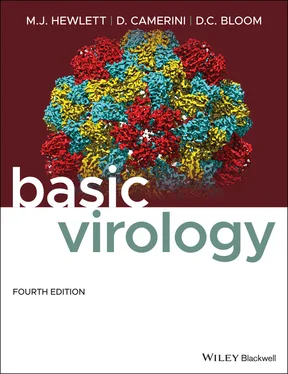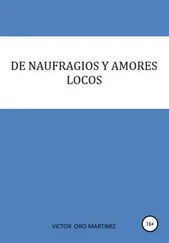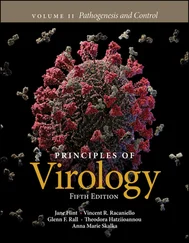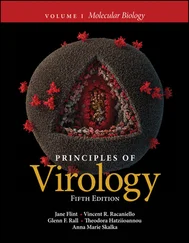Additional Reading for Part I
Note: See Resource Center for relevant websites .
1 Ahmed, R., Morrison, L.A., and Knipe, D.M. (1995). Persistence of viruses. In: Virology, 3e (eds. B.N. Fields and D.M. Knipe), 219–250. New York: Raven Press.
2 Baer, G.M. and Tordo, N. (1994). Rabies virus. In: Encyclopedia of Virology (eds. R.G. Webster and A. Granoff), 1180–1185. New York: Academic Press.
3 Barry, J.M. (2004). The Great Influenza: The Epic Story of the Greatest Plague in History. New York: Viking.
4 Baum, S.G. (2004). Acute viral meningitis and encephalitis. In: Infectious Diseases, 3e (eds. S.L. Gorbach, J.G. Bartlett and N.R. Blacklow), 1286–1291. Philadelphia: W.B. Saunders.
5 DeFilippis, V.R. and Villarreal, L.P. (1999). An introduction to the evolutionary ecology of viruses. In: Viral Ecology (ed. C.J. Hurst), 125–208. New York: Wiley.
6 Diamond, J. (1999). Guns, Germs, and Steel: The Fates of Human Societies. New York: W.W. Norton.
7 Domingo, E., Webster, R.G., and Holland, J.J. (eds.) (1999). Origin and Evolution of Viruses. San Diego, CA: Academic Press.
8 Fan, H., Conner, R.F., and Villarreal, L.P. (1989). The Biology of AIDS. Boston: Jones and Bartlett.
9 Fenner, F.J., Gibbs, E.P.J., Murphy, F.A. et al. (1993). Veterinary Virology, 2e, chaps. 4, 6, 7, 8, and 9. San Diego, CA: Academic Press.
10 Haase, A.T. (1997). Methods in viral pathogenesis: tissues and organs. In: Viral Pathogenesis (ed. N. Nathanson), 465–482. Philadelphia: Lippincott‐Raven.
11 Koff, R.S. (2004). Hepatitis C. In: Infectious Diseases (eds. S.L. Gorbach, J.G. Bartlett and N.R. Blacklow), 2072–2074. Philadelphia: W.B. Saunders.
12 Koff, R.S. (2004). Hepatitis E. In: Infectious Diseases (eds. S.L. Gorbach, J.G. Bartlett and N.R. Blacklow), 2074–2076. Philadelphia: W.B. Saunders.
13 Koff, R.S., Hepatitis, B., and hepatitis, D. (1998). Infectious Diseases (eds. S.L. Gorbach, J.G. Bartlett and N.R. Blacklow) chap. 91. Philadelphia: W.B. Saunders.
14 Kolata, G. (2001). Flu: The Story of the Great Influenza Pandemic. New York: Touchstone.
15 Lemon, S.M. (1998). Type A viral hepatitis. In: Infectious Diseases (eds. S.L. Gorbach, J.G. Bartlett and N.R. Blacklow) chap. 90. Philadelphia: W.B. Saunders.
16 McNeill, W. (1996). Patterns of disease emergence in history. In: Emerging Viruses (ed. Morse), 29–36. New York: Oxford University Press.
17 Morse, S.S. (1996). Examining the origins of emerging viruses. In: Emerging Viruses (ed. S.S. Morse), 10–28. New York: Oxford University Press.
18 Nathanson, N. (2001). Epidemiology. In: Virology, 4e (eds. B.N. Fields and D.M. Knipe) chap. 14. New York: Raven Press.
19 Nathanson, N. and Tyler, K.L. (1997). Entry dissemination, shedding, and transmission of viruses. In: Viral Pathogenesis (ed. N. Nathanson) chap. 2. Philadelphia: Lippincott‐Raven.
20 Oldstone, M.B.A. (1998). Viruses, Plagues, and History. New York: Oxford University Press.
21 Porterfield, J.S. and Htraavik, T. (1994). Encephalitis viruses. In: Encyclopedia of Virology (eds. R.G. Webster and A. Granoff), 362–371. New York: Academic Press.
22 Preston, R. (1994). The Hot Zone. New York: Random House.
23 Prusiner, S.B., Telling, G., Cohen, G., and DeArmond, S. (1996). Prion diseases of humans and animals. Seminars in Virology 7: 159–174.
24 Rotbart, H.A. (1991). Viral meningitis and the aseptic meningitis syndrome. In: Infections of the Central Nervous System (eds. W.M. Scheld, R.J. Whitley and D.T. Durack), 19. New York: Raven Press.
25 Scheld, W.M., Armstrong, D., and Hughes, J.M. (eds.) (1998). Emerging Infections, vol. 1 and 2. Washington, DC: ASM Press.
26 Shope, R.E. (1994). Rabies‐like viruses. In: Encyclopedia of Virology (eds. R.G. Webster and A. Granoff). New York: Academic Press.
27 Shope, R.E. and Evans, A.S. (1996). Assessing geographic and transport factors and recognition of new viruses. In: Emerging Viruses (ed. S.S. Morse), 109–119. New York: Oxford University Press.
28 Smith, A.L. and Barthold, S.W. (1997). Methods in viral pathogenesis: animals. In: Viral Pathogenesis (ed. N. Nathanson), 483–506. Philadelphia: Lippincott‐Raven.
29 Villarreal, L.P. (1997). On viruses, sex, and motherhood. Journal of Virology 71: 859–865.
30 Villarreal, L.P. (2004). Viruses and the Evolution of Life. Washington, DC: ASM Press.
31 Woese, C.R., Kandler, O., and Wheelis, M.L. (1990). Towards a natural system of organisms: proposal for the domains Archaea, Bacteria, and Eucarya. Proceedings of the National Academy of Sciences 87: 4576–4579.
PART II
Basic Properties of Viruses and Virus–Cell Interaction
Virus Structure and ClassificationThe Features of a VirusClassification SchemesThe VirosphereThe Human Virome
The Beginning and End of the Virus Replication CycleOutline of the Virus Replication CycleViral EntryLate Events in Viral Infection: Capsid Assembly and Virion Release
The Innate Immune Response: Early Defense Against PathogensHost Cell-Based Defenses Against Virus ReplicationThe Adaptive Immune Response and the Lymphatic SystemControl and Dysfunction of ImmunityMeasurement of the Immune Reaction
Strategies to Protect Against and Combat Viral InfectionVaccination – Induction of Immunity to Prevent Virus InfectionEukaryotic Cell-Based Defenses Against Virus ReplicationAntiviral DrugsBacterial Antiviral Systems – Restriction Endonucleases
Problems for Part II
Additional Reading for Part II
CHAPTER 5 Virus Structure and Classification
THE FEATURES OF A VIRUS
Viral genomes
Viral capsids
Viral envelopes
CLASSIFICATION SCHEMES
The Baltimore scheme of virus classification
Disease‐based classification schemes for viruses
THE VIROSPHERE
QUESTIONS FOR CHAPTER 5
Viruses are small compared to the wavelength of visible light; indeed, while the largest virus can be discerned in a good light microscope, the vast majority of viruses can only be visualized in detail using an electron microscope. A size scale with some important landmarks is shown in Figure 5.1.
Virus particles are composed of a nucleic acid genomeor core, which is the genetic material of the virus, surrounded by a capsidmade up of virus‐encoded proteins. Viral genetic material encodes the structural proteinsof the capsid and other viral proteins essential for other functions in initiating virus replication. The entire structure of the virus (the genome, the capsid, and – where present – the envelope) makes up the virionor virus particle. The exterior of this virion contains proteins that interact with specific proteins on the surface of the cell in which the virus replicates. The schematic structures of some well‐characterized viruses are shown in Figure 5.2.
To date, more than 5000 different genotypes of viruses have been identified, and it is estimated that there may be as many as 10 6in a kilogram of marine sediment. The National Center for Biological Information (NCBI) database contains more than 8000 complete viral genomes as February 2019. Although perhaps not as overwhelming, the number of different types of viruses associated with terrestrial plants and animals is very high, and, of course, bacteria and protists all have their own populations of associated viruses. Further, there are a very large number of subviral entities, which depend on viruses themselves for replication – these are subviral infectious agents and plant satellite nucleic acid elements that share at least some features of their replication strategies with viruses. And, finally, as we have noted briefly in Part I, there are infectious proteins (prions), which also can be studied using the techniques of virology.
Читать дальше












